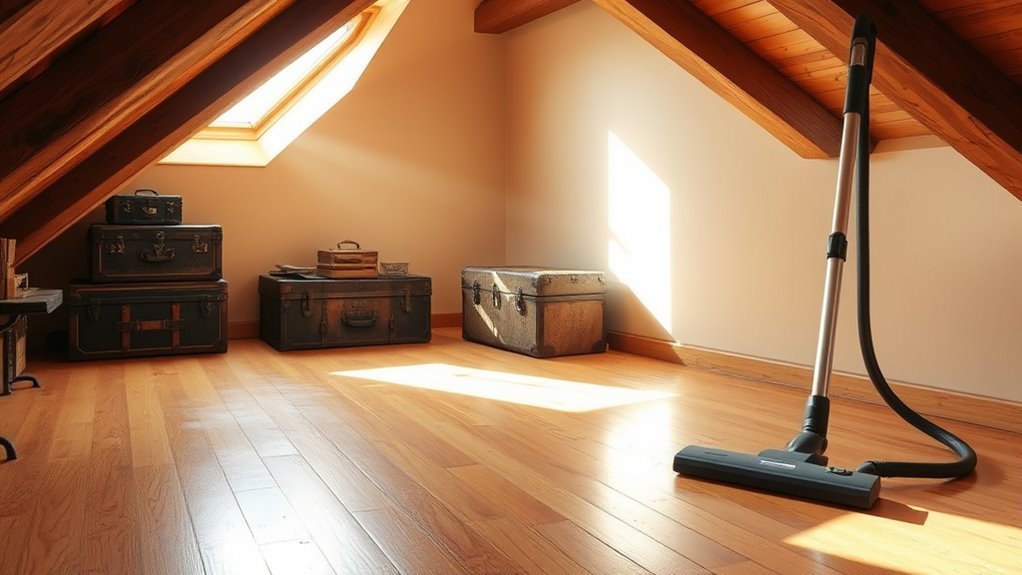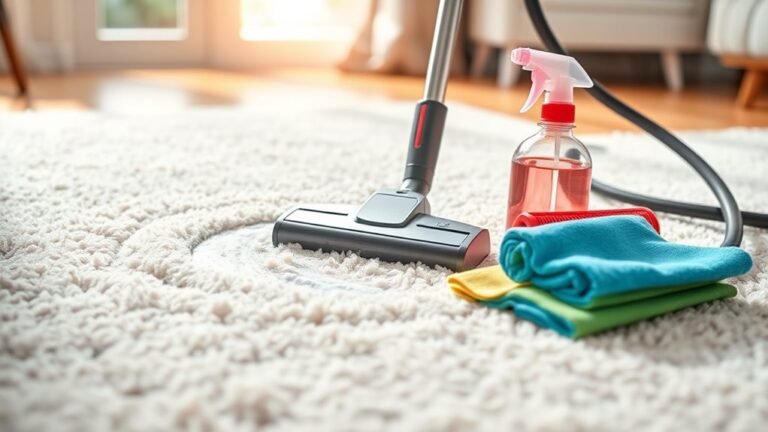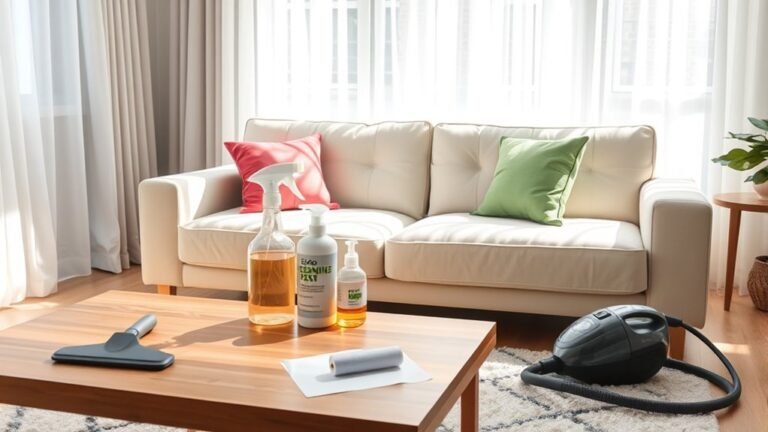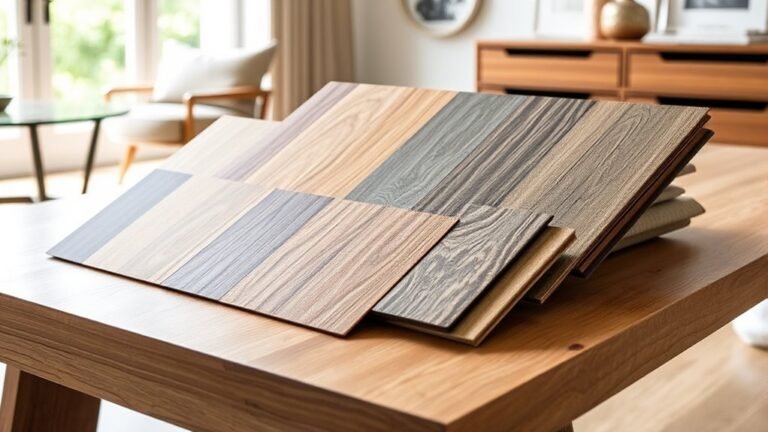Deep Cleaning Guide for Attic Flooring
To deep clean your attic flooring safely and effectively, start by clearing all stored items and wearing protective gear like gloves, masks, and goggles. Use a HEPA vacuum to remove dust and debris without stirring particles, then gently scrub any mold with a vinegar solution, ensuring the floor dries thoroughly. Tailor your cleaning method to your floor type—wood, concrete, or carpet—while inspecting for damage. Proper ventilation and hazard checks are essential for your health and safety. Keep exploring to master thorough attic floor care.
Preparing Your Attic for Cleaning
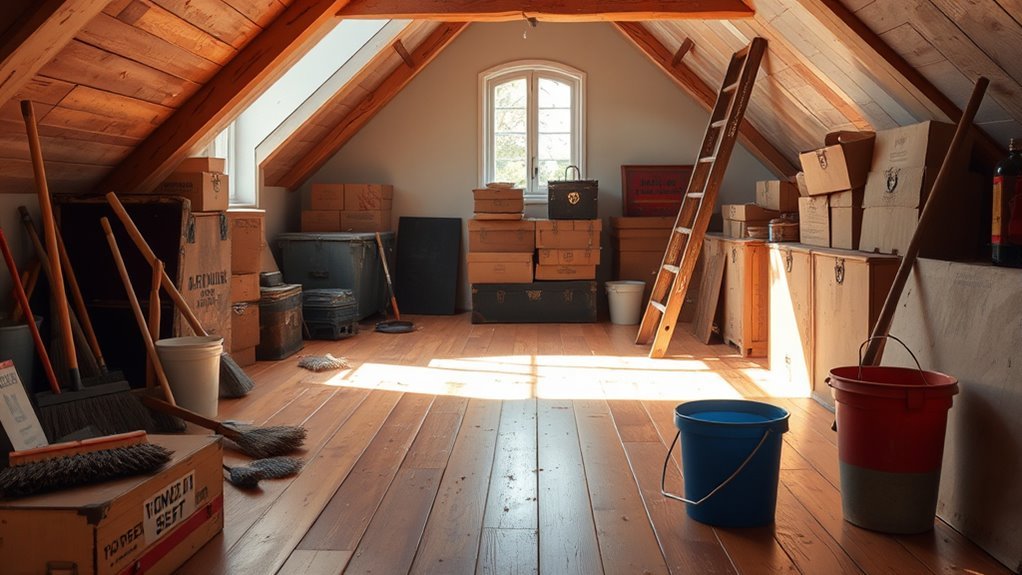
Before you begin deep cleaning your attic flooring, you’ll need to thoroughly prepare the space to guarantee safety and efficiency. Start by removing stored items to create clear access and improve attic organization. Use sturdy containers or labels to sort belongings, ensuring you can easily restore order later. Check that the attic is well-ventilated and free of hazards such as exposed nails or weak flooring. Establish a consistent cleaning schedule to maintain cleanliness and prevent dust buildup over time. Wear protective gear like gloves and a mask to shield yourself from allergens and debris. It’s also important to conduct a thorough attic inspection to identify any structural integrity issues or hidden problems before cleaning. By preparing your attic carefully, you’ll create a safer, more manageable environment that maximizes your freedom to clean effectively and maintain a clutter-free space.
Essential Tools and Materials Needed
When tackling deep cleaning of your attic flooring, having the right tools and materials on hand is essential to assure both efficiency and safety. Start with sturdy gloves, a high-quality dust mask, and protective eyewear to shield yourself from dust and debris. You’ll need a reliable vacuum with a HEPA filter to remove fine particles effectively. Include a stiff-bristled broom and a microfiber mop for thorough scrubbing and dusting. Use gentle, non-toxic cleaning solutions suited for wood or plywood surfaces to preserve your attic’s flooring integrity. Don’t forget a flashlight or portable work light to illuminate dark corners. Having this cleaning equipment ready assures you maintain your floor’s condition while protecting yourself, allowing you the freedom to work confidently and achieve a spotless, safe attic space. Regularly inspecting for early signs of damage can help prevent costly repairs and maintain the longevity of your attic flooring.
Assessing the Condition of Attic Flooring
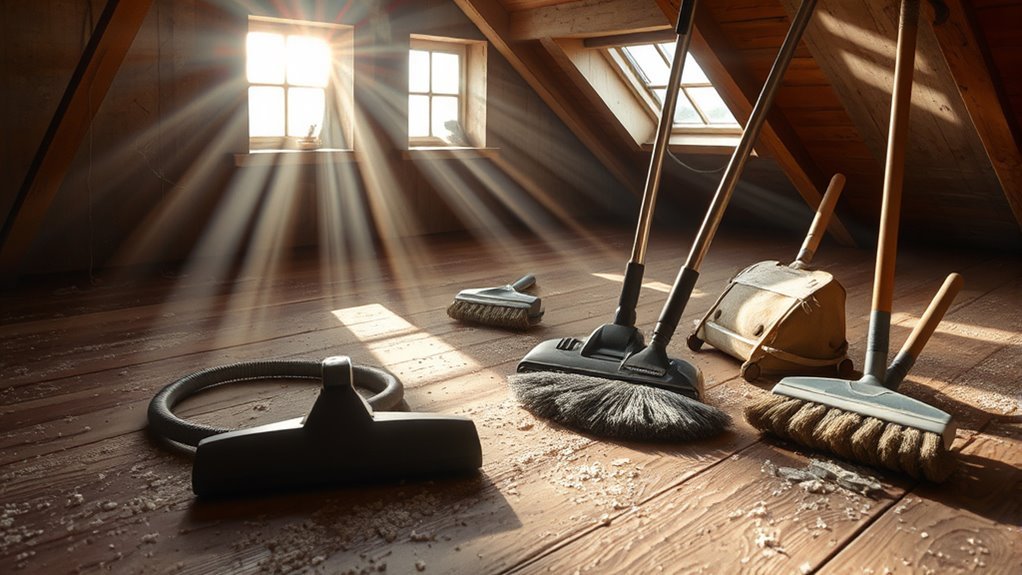
Before you start cleaning, carefully inspect the attic flooring for any visible cracks, soft spots, or sagging that could indicate structural damage. Pay close attention to signs of moisture or mold, which can compromise both the wood and your health. Use a strong flashlight and wear protective gear to guarantee a thorough and safe assessment.
Visual Inspection Techniques
Three key steps will guide you through a thorough visual inspection of your attic flooring to accurately assess its condition. First, use an inspection checklist to guarantee you methodically examine every section of the flooring. Next, focus on visual cues such as discoloration, staining, or warping, which might indicate moisture issues or material degradation. Finally, check for any loose or missing boards, confirming the flooring remains stable and secure. Always wear protective gear like gloves and a dust mask to safeguard your freedom to explore without harm. By systematically applying these visual inspection techniques, you’ll gain a clear understanding of your attic floor’s state, making your deep cleaning efforts more effective and preserving the structural integrity without venturing into structural damage assessment yet.
Identifying Structural Damage
Although visual inspections provide valuable initial insights, identifying structural damage requires a more focused assessment of your attic flooring’s integrity. You’ll want to carefully evaluate joists and boards for signs of compromised structural integrity such as cracks, sagging, or weakened fasteners. Prioritize safety by using proper lighting and protective gear during your damage assessment. Here’s a quick guide to help you spot critical issues:
| Sign | What It Indicates |
|---|---|
| Cracks in beams | Potential weakening of support |
| Sagging or uneven flooring | Loss of load-bearing capacity |
| Loose or missing nails | Reduced structural connections |
| Rot or decay in wood | Severe compromise in structural integrity |
Moisture and Mold Signs
After confirming the structural soundness of your attic flooring, the next step is to check for moisture and mold, which can silently undermine both the wood and your home’s air quality. Begin with moisture detection by using a moisture meter on all wooden surfaces; high readings indicate potential water intrusion. Inspect for visible mold patches, discoloration, or a musty odor—common signs that require immediate attention. Wear protective gear like gloves and a mask to avoid exposure while evaluating. For mold prevention, confirm proper attic ventilation and repair any roof leaks promptly. Addressing moisture issues early preserves your attic’s integrity and safeguards your freedom from costly repairs or health hazards. Regular monitoring is key to maintaining a dry, mold-free attic environment.
Removing Dust and Loose Debris
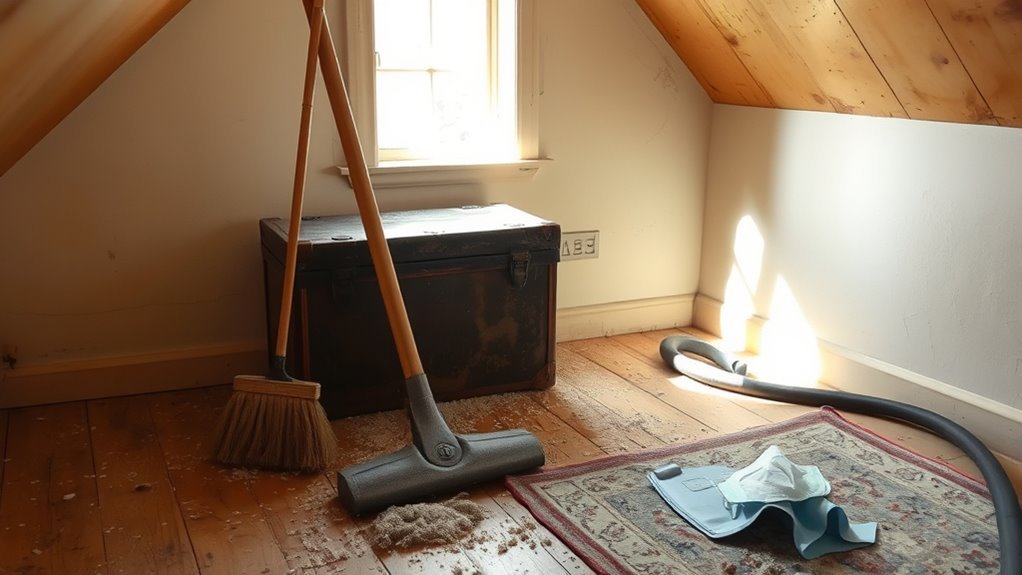
Before you begin deep cleaning your attic flooring, it’s vital to carefully remove dust and loose debris to prevent it from spreading or causing respiratory issues. Start by wearing a high-quality dust mask and gloves to protect yourself. Use a vacuum with a HEPA filter for effective dust removal techniques, making sure you cover all corners and crevices. Avoid sweeping, as it can stir up dust particles. For loose debris like wood chips or insulation fragments, gently collect them with a stiff broom or brush, then dispose of them using proper debris disposal methods—seal debris in heavy-duty bags to prevent contamination. Proper removal not only safeguards your health but also guarantees your attic stays clean, creating a safer, fresher space that supports your freedom to maintain your home confidently. Regularly changing air filters helps reduce the amount of dust entering your attic, contributing to a cleaner environment.
Tackling Mold and Mildew on Attic Floors
When you notice mold or mildew on your attic floors, it’s essential to address the issue promptly to prevent structural damage and health risks. Start by wearing protective gear—gloves, mask, and goggles—to avoid inhaling spores. Use a mixture of water and white vinegar or a commercial mildew removal solution to scrub affected areas gently with a soft brush. Avoid saturating the wood to prevent further moisture retention. After cleaning, dry the area thoroughly using fans or dehumidifiers to inhibit regrowth. For mold prevention, improve attic ventilation and inspect for leaks regularly. Keeping humidity below 60% is critical. Regular inspections and swift action will help you maintain a healthy attic environment and protect your home’s structural integrity from mold and mildew damage. Using natural cleaning solutions like vinegar can effectively combat mold while maintaining a healthy space without harsh chemicals.
Cleaning Different Types of Attic Flooring
Although attic flooring materials vary widely, each type demands a specific cleaning approach to guarantee safety and preserve structural integrity. For carpet flooring, vacuum thoroughly and spot-clean stains, ensuring insulation types underneath remain undisturbed. Hardwood flooring requires gentle sweeping and a damp mop to avoid warping, while vinyl flooring benefits from mild detergents and soft cloths. Concrete flooring can withstand scrubbing but check for cracks that might harbor pests. Always consider pest control when cleaning to prevent infestations. Establishing a cleaning schedule with manageable tasks can help maintain your attic flooring in optimal condition.
| Flooring Type | Recommended Cleaning Method |
|---|---|
| Carpet Flooring | Vacuum, spot clean, avoid soaking |
| Hardwood | Sweep, damp mop, avoid excess water |
| Vinyl | Mild detergent, soft cloth |
| Concrete | Scrub, inspect for cracks & pests |
Tailor your cleaning to each material’s needs for lasting attic freedom.
Safety Precautions During Attic Cleaning
Before you start cleaning your attic flooring, make certain you’re equipped with essential protective gear like gloves, a respirator, and sturdy footwear. Carefully inspect the area to identify hazards such as exposed nails, unstable flooring, or insulation materials that could pose health risks. Taking these precautions seriously will help you avoid accidents and guarantee a safer cleaning process. Additionally, ensuring proper ventilation during cleaning is crucial to prevent moisture buildup and maintain air quality.
Protective Gear Essentials
Anyone tackling attic cleaning needs to prioritize protective gear to safeguard against hazards like dust, mold, and sharp debris. Without the right equipment, you risk respiratory issues, eye injuries, and skin irritation. Here’s what you must wear:
- Protective gloves – Choose durable, chemical-resistant gloves to prevent cuts and exposure to irritants.
- Safety goggles – Use snug-fitting goggles to shield your eyes from airborne particles and debris.
- Respirator mask – Opt for a mask rated for dust and mold spores to protect your lungs.
- Long-sleeve clothing – Wear tightly woven, long-sleeve shirts and pants to minimize skin contact with allergens.
Equipping yourself properly guarantees you clean freely and safely, minimizing health risks while maintaining thoroughness during attic flooring restoration.
Hazard Identification Tips
Wearing the right protective gear is only part of staying safe during attic cleaning—you also need to recognize potential hazards before you start. Begin by conducting a thorough visual inspection to develop hazard awareness. Look for exposed nails, loose boards, and damaged insulation that could cause injury. Pay close attention to debris identification; attic floors often hide sharp objects, rodent droppings, or broken glass. Use a flashlight to detect hidden dangers in dark corners. Be mindful of electrical wiring—avoid stepping near frayed or exposed cables. If you spot mold or excessive dust, take extra precautions to prevent respiratory issues. By methodically identifying these hazards, you’ll protect yourself and guarantee a successful, safe attic cleaning experience that keeps your freedom intact.
Improving Air Quality After Cleaning
Although thorough cleaning removes much of the dust and debris from your attic flooring, the air quality can still be compromised by lingering particles and contaminants. To restore healthy air, focus on effective air purification and optimized ventilation systems. Here’s how you can improve your attic’s air quality after cleaning:
- Install a high-efficiency particulate air (HEPA) purifier to trap microscopic dust and allergens.
- Verify your attic’s ventilation system is clean and unobstructed for continuous airflow.
- Use exhaust fans or open vents to expel stale air and reduce moisture buildup.
- Monitor humidity levels with a hygrometer; maintain them between 30-50% to prevent mold growth.
- Regular inspections, ideally twice a year, can help detect early signs of mold and maintain proper airflow to ensure ongoing air quality.
Maintenance Tips to Keep Your Attic Floor Clean
Maintaining the cleanliness of your attic floor after a deep cleaning is key to preserving the improved air quality and preventing the buildup of dust and debris. To keep your attic floor pristine, establish a routine seasonal maintenance schedule—inspect and vacuum at least twice a year, ideally before and after winter. Prioritize attic organization by storing items in sealed containers to minimize dust accumulation and avoid clutter that can trap dirt. Always wear protective gear such as gloves and a mask during upkeep to safeguard your health. Additionally, check for signs of moisture or pests that could compromise cleanliness. By following these focused maintenance tips, you’ll guarantee your attic floor remains clean, safe, and free, supporting the overall health of your home environment. Incorporating regular cleaning and maintenance schedules helps maintain long-term cleanliness and reduces the effort needed for future deep cleans.
Frequently Asked Questions
Can Attic Flooring Support Heavy Furniture After Cleaning?
You’ll want to carefully assess your attic weight capacity before placing heavy furniture. Cleaning alone doesn’t assure the floor can support added loads. Check joist spacing, thickness, and material integrity to confirm safety. When positioning furniture, distribute weight evenly to avoid stress on weak spots. If unsure, consult a structural engineer to prevent damage or injury. Prioritize safety to enjoy the freedom of using your attic confidently without risking collapse.
How Often Should Insulation Be Replaced During Attic Floor Cleaning?
They say, “An ounce of prevention is worth a pound of cure.” You should replace insulation every 15 to 25 years, depending on its lifespan and condition. During attic floor cleaning, inspect for damage, moisture, or compression that reduces energy efficiency. Prioritize safety by wearing protective gear and ensuring proper ventilation. Timely replacement not only maintains comfortable temperatures but also helps you keep freedom from high energy bills and unexpected repairs.
What Is the Best Way to Seal Attic Floor Gaps Post-Cleaning?
To effectively seal attic floor gaps post-cleaning, you’ll want to explore sealant options like expanding foam or caulk for smaller gaps, and backer rod combined with spray foam for larger spaces. Start by cleaning the area thoroughly, then apply the sealant carefully to guarantee complete gap filling. Always wear protective gear to avoid inhaling fumes or dust. Proper sealing not only improves energy efficiency but also keeps pests out, giving you greater control over your home’s comfort.
Are There Eco-Friendly Products Suitable for Attic Floor Deep Cleaning?
They say, “Cleanliness is next to godliness,” and when it comes to attic floors, you’ll want to choose natural cleaners that’re both effective and eco-friendly. Green solutions like vinegar, baking soda, and castile soap work wonders without harsh chemicals. Always wear gloves and guarantee proper ventilation to protect yourself. These options keep your attic safe and clean, giving you the freedom to maintain a healthy, sustainable home environment.
How Can Pest Infestations Affect Attic Flooring Cleanliness?
Pest infestations can severely compromise attic flooring cleanliness by leaving droppings, nesting materials, and damaging the structure. You’ll want to prioritize pest control to prevent contamination and structural issues. Implement infestation prevention strategies like sealing entry points and maintaining cleanliness. Always use safe, non-toxic treatments to protect your health and freedom to enjoy a clean, secure attic space. Regular inspections help guarantee your flooring stays pest-free and spotless.
